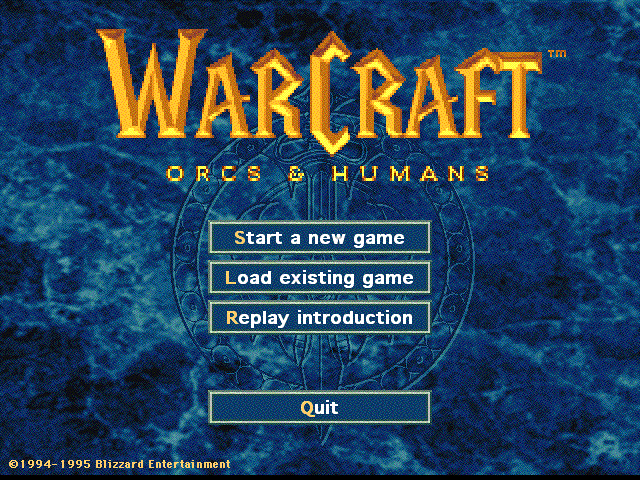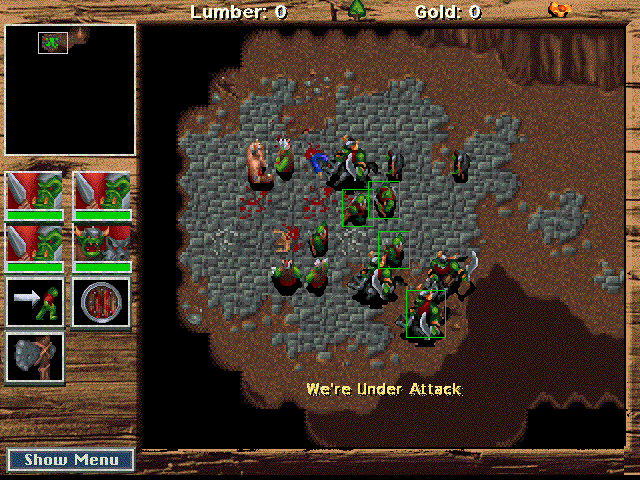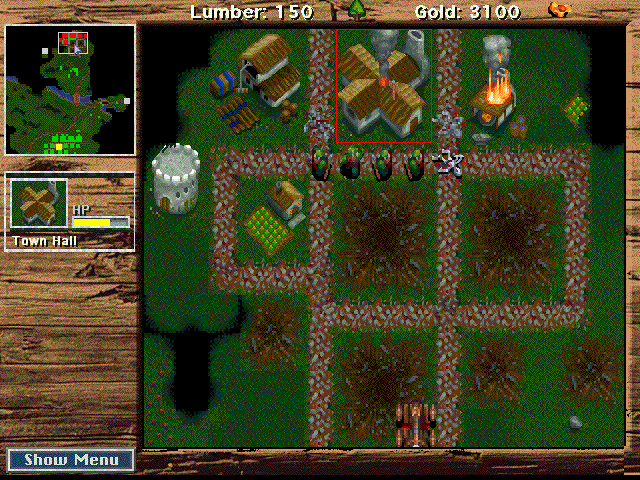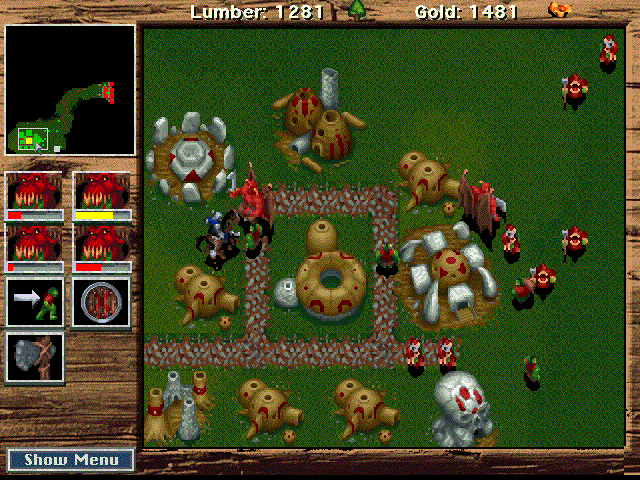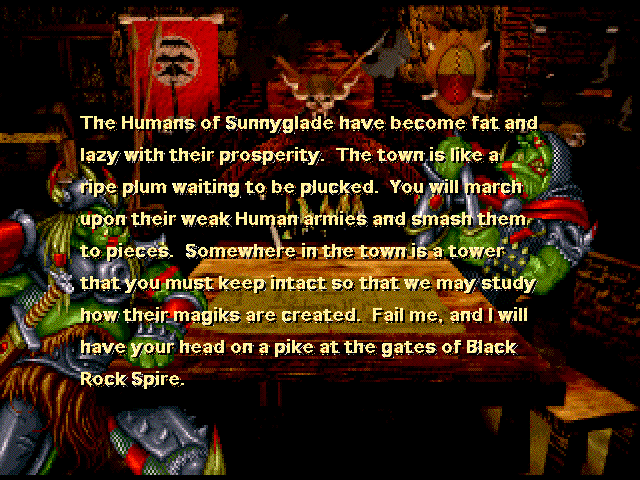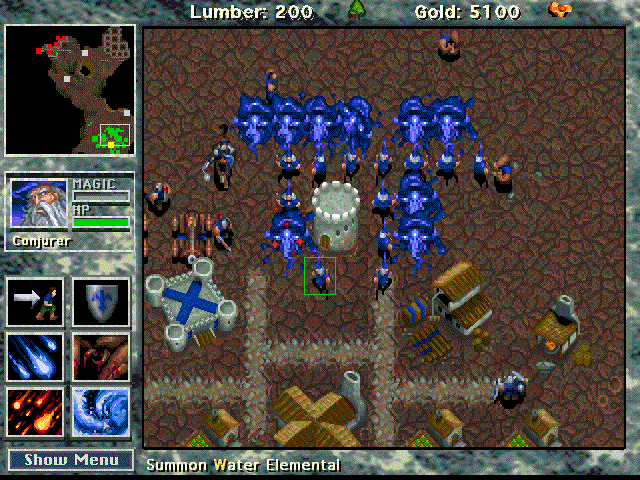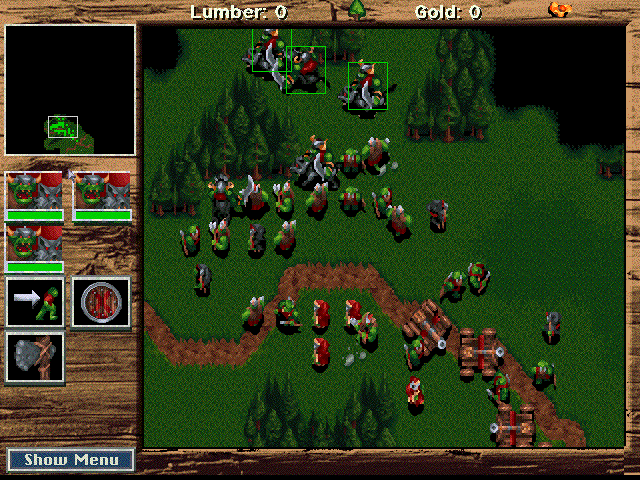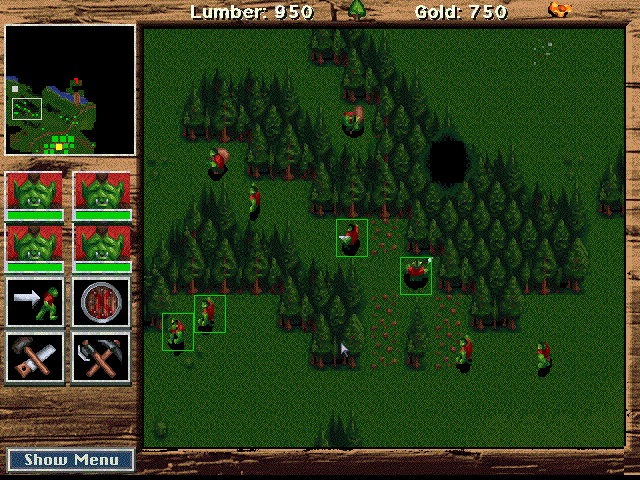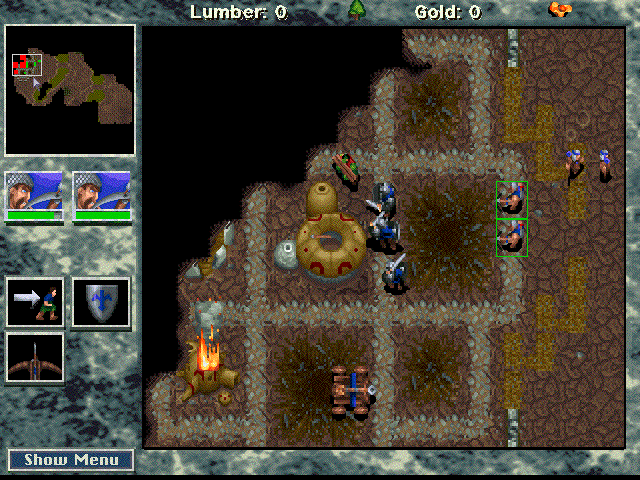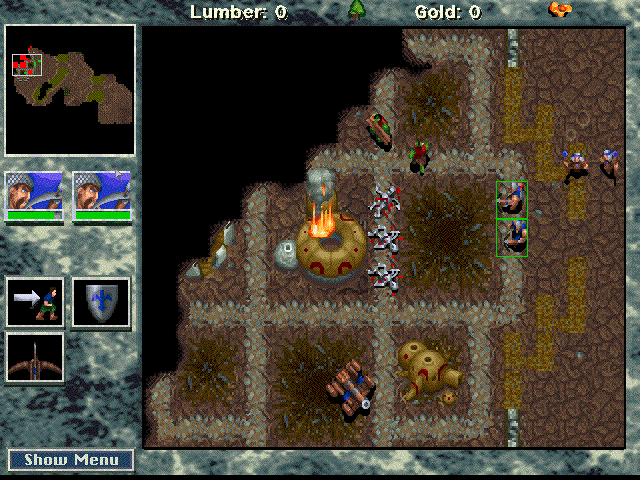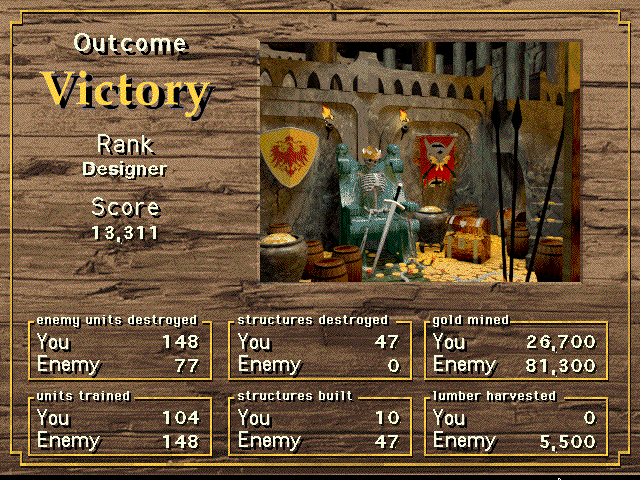Warcraft: Orcs & Humans – Blizzard - 1995 - First time playing?: Yes!
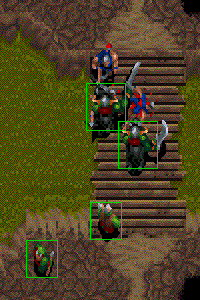 In Warcraft, there are orcs, but also there are humans. They don't like each other very much.
In Warcraft, there are orcs, but also there are humans. They don't like each other very much.
Alright, that's all the story stuff out of the way. (Unless you read the manual, naturally, which contains much more lore that doesn’t come up much in-game.) So, Warcraft. I'm not super RTS savvy, I'll be the first to admit. I have always gravitated more towards turn-based strategy such as Heroes of Might & Magic and Age of Wonders. I have however been interested in expanding my strategy horizons and also been interested in the back catalogue of Blizzard for quite some time, y'know, from before they were evil and when you could buy a physical copy of one of their games and just be allowed to own it forever and play it offline, even be able to play multiplayer over LAN without requiring being connected to a server and not even needing the CD in your computer if you downloaded the latest official patch for the game. Oh no, I'm making myself sad.
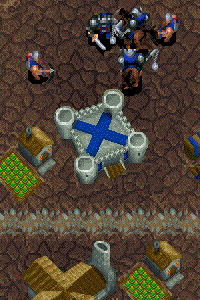 Anyway, Blizzard’s support for Macintosh in the 90s to early 2000s was excellent, with Mac versions of their games typically being included on the same CDs as their DOS and Windows counterparts, resulting in their games being much more widely spread than most Mac ports which were usually doomed to a limited release that were only stocked in dedicated Apple stores. Mac unfortunately missed out on The Lost Vikings, Blizzard’s often overlooked cute and cartoony duology of puzzle platformers about, well, Vikings that want to go home. Wow, you really can just summarize the story of all of Blizzard’s earliest games by reading the title alone, huh? Anyway, while we missed out on those gems, Mac did still get ports of Blackthorne, Warcraft I-III, Starcraft and Diablo I and II, with all of their expansions except for Diablo: Hellfire also getting widespread Mac releases. I suspect the only reason we missed out on Hellfire was because it wasn't developed in-house by Blizzard themselves. I've started collecting Blizzard’s Mac library, and I intend to play through and review them all. Blackthorne will have to wait as it's significantly harder to find than the rest, so we’re starting with Warcraft: Orcs and Humans.
Anyway, Blizzard’s support for Macintosh in the 90s to early 2000s was excellent, with Mac versions of their games typically being included on the same CDs as their DOS and Windows counterparts, resulting in their games being much more widely spread than most Mac ports which were usually doomed to a limited release that were only stocked in dedicated Apple stores. Mac unfortunately missed out on The Lost Vikings, Blizzard’s often overlooked cute and cartoony duology of puzzle platformers about, well, Vikings that want to go home. Wow, you really can just summarize the story of all of Blizzard’s earliest games by reading the title alone, huh? Anyway, while we missed out on those gems, Mac did still get ports of Blackthorne, Warcraft I-III, Starcraft and Diablo I and II, with all of their expansions except for Diablo: Hellfire also getting widespread Mac releases. I suspect the only reason we missed out on Hellfire was because it wasn't developed in-house by Blizzard themselves. I've started collecting Blizzard’s Mac library, and I intend to play through and review them all. Blackthorne will have to wait as it's significantly harder to find than the rest, so we’re starting with Warcraft: Orcs and Humans.
So, what did I think about Warcraft?
Okay, I really hope this isn't sacrilege.
Warcraft I is a massive pain in the arse and I really do not care for it.
Let me make it clear, I don't hate Warcraft by any means. There's a lot of good in Warcraft I that has laid some very solid foundations for sequels that I intend to play and can see myself enjoying. The game is easy to understand and learn even without the manual, while still preserving all that base building and party composition goodness and unit positioning of the genre that makes it so fun. Warcraft understands the game flow of real-time strategy games well.
It's just so clunky though.
But before we go into why it's so clunky, I better lay out the mechanics here.
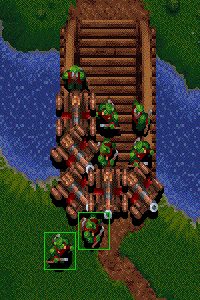 The game has two campaigns for you to play through with 12 levels each. You can play as the orcs, who are hilariously evil and cool and hunky and badass, or you can play as the humans who are boring, have beards and are incapable of saying anything but “Yes my Lord” or just “Yes” any time you tell them to do something. Yeah, I immediately jumped on playing as the orcs to start out. After playing Civilization and committing war crimes across millenia in the name of mankind, I think it's time someone puts humanity in their place. I did beat both campaigns in the end however, to get the most complete Warcraft experience.
The game has two campaigns for you to play through with 12 levels each. You can play as the orcs, who are hilariously evil and cool and hunky and badass, or you can play as the humans who are boring, have beards and are incapable of saying anything but “Yes my Lord” or just “Yes” any time you tell them to do something. Yeah, I immediately jumped on playing as the orcs to start out. After playing Civilization and committing war crimes across millenia in the name of mankind, I think it's time someone puts humanity in their place. I did beat both campaigns in the end however, to get the most complete Warcraft experience.
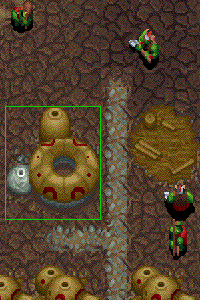 Levels typically start you out with a small base consisting of a town hall and a few farms. Town halls produce either peons if you're playing as the orcs, or peasants if you play as the humans. Aside from the names and designs however, they're functionally identical; unarmed worker units who are used to retrieve gold from mines, chop trees for lumber and build more facilities with those two resources. Once you build barracks, you can now spend gold to train military units to fight the opposing side with. How many units you can have at once depends on how many farms you have built. Each farm built makes enough food to sustain four more units, so you'll frequently need to build more as you build up your army. Other buildings will allow you to increase the damage, defence or speed of certain units, as well as granting access to even more units that can be trained in the barracks.
Levels typically start you out with a small base consisting of a town hall and a few farms. Town halls produce either peons if you're playing as the orcs, or peasants if you play as the humans. Aside from the names and designs however, they're functionally identical; unarmed worker units who are used to retrieve gold from mines, chop trees for lumber and build more facilities with those two resources. Once you build barracks, you can now spend gold to train military units to fight the opposing side with. How many units you can have at once depends on how many farms you have built. Each farm built makes enough food to sustain four more units, so you'll frequently need to build more as you build up your army. Other buildings will allow you to increase the damage, defence or speed of certain units, as well as granting access to even more units that can be trained in the barracks.
There's not a huge amount of different units for you to command. Each side has seven main units alongside two summons. Most of the units are pretty similar between the two sides, with a few exceptions. Peasants and peons we've already gone over, but in addition to that there's your basic melee fighters, ranged attackers (archers for humans, spear throwers for orcs), mounted melee units (horseback knights for humans, wolf riding raiders for orcs), catapults, healers and summoners. Healers is a bit of a generalisation, to be fair. Humans have clerics for their healing units which fit into the traditional white mage role well, while the orcs instead have Necrolytes, who instead of traditional healing spells can resurrect dead units, both orc and human, into skeletal servants to fight alongside them. In addition, the cleric can make units invisible, while the necrolyte can increase a unit’s defence. As for the summoners, orcs get warlocks, who are capable of summoning spiders and daemons as well as casting a poison mist attack. Humans meanwhile have conjurers, who summon scorpions and water elementals, in addition to casting a fire rain attack. Spiders and scorpions are basically the same, but as for daemons and water elementals, the former is a melee attacker while the latter is a ranged attacker. Both daemons and water elementals are the strongest units in the game by far, so you don't get access to them until near the end of the game.
With the exception of the tutorial missions, your primary objective is simply to wipe out all enemy forces entirely. Destroy their buildings, destroy their units, don't stop until they have absolutely nothing left to either attack you with or rebuild with. Sometimes there will be an additional objective on top of that such as rescuing a specific NPC or leaving a specific building intact, but on the whole, total annihilation is more or less the way to victory, with the mission briefing cutscene prior to each level giving you a vague justification of what your massacre will accomplish in the war. The human mission briefings are boring, but the orc briefings are consistently hilarious with how cartoonishly evil they are and the sheer disgust in their voice at all times. Shout outs to the mission briefing where it opens with the orcs bodyshaming the humans by calling them fat and lazy as if that’s the primary drive reason why the orcs want to slaughter this settlement, with the actual objective of capturing the mage tower only coming up later. I had to restart that mission a few times, but the hammy delivery of that stupid opening line cheered me up every time I did. Some levels do mix things up however. Certain levels are more akin to dungeon crawls, not giving you access to any base building and instead requiring you to manage with the starting units the game gives you and nothing else. I like this idea in theory, but it's kind of clumsily implemented. In a few dungeon crawl missions, you can clear out a large chunk of the opposition by simply not moving at the start of the level and waiting for the enemy units to just walk straight into your line of fire. There's another reason I don't care for these missions, but we'll get to that later.
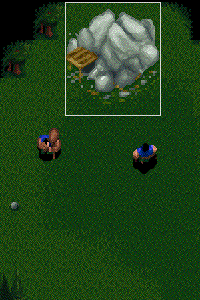 Again, Warcraft I does have a lot of good design. The way gold is handled is really well implemented. How much gold a mine has is finite, so once the mine is emptied you'll need to find another one to keep the income flowing. I like this because it prevents the player from relying on overly defensive playstyles. If gold was infinite, you could potentially succeed just by spamming massive amounts of units to surround your base in, thus fighting off any invaders until you have such strength in numbers that strategy is no longer important and you can just effortlessly overwhelm the enemy base. When the mines close to your base are depleted, that forces you to start getting gold from the mines further away from your barracks, where there’s more of a chance for enemy forces to come in and slaughter your peons/peasants, thus requiring further spreading of your defensive forces to protect them, or forming blockades at chokepoints that prevent enemy units from even entering the same region as the peons. It keeps the strategy required to clear levels evolving and dynamic as you're required to gradually spread out your military forces to better guard your peons/peasants from attacks.
Again, Warcraft I does have a lot of good design. The way gold is handled is really well implemented. How much gold a mine has is finite, so once the mine is emptied you'll need to find another one to keep the income flowing. I like this because it prevents the player from relying on overly defensive playstyles. If gold was infinite, you could potentially succeed just by spamming massive amounts of units to surround your base in, thus fighting off any invaders until you have such strength in numbers that strategy is no longer important and you can just effortlessly overwhelm the enemy base. When the mines close to your base are depleted, that forces you to start getting gold from the mines further away from your barracks, where there’s more of a chance for enemy forces to come in and slaughter your peons/peasants, thus requiring further spreading of your defensive forces to protect them, or forming blockades at chokepoints that prevent enemy units from even entering the same region as the peons. It keeps the strategy required to clear levels evolving and dynamic as you're required to gradually spread out your military forces to better guard your peons/peasants from attacks.
There's also a solid rock-paper-scissors kind of dynamic with the way the units are balanced. For instance, the catapult fires a slow moving explosive projectile with splash damage and a slow rate of fire, which is excellent at taking out units such as archers or conjurers, ranged attackers that don't move much and will struggle to get out of the way of the explosion’s splash damage in time, but they're near helpless against knights who can quickly rush past the projectiles on horseback and destroy the catapult at melee range, which the catapult is incapable of countering. Meanwhile however, a condensed group of spearmen will be able to potentially take out the knight before he can even get in attack range, as the thrown spears are fast-moving, accurate and have a high rate of fire. So, we have a dynamic where the catapult is strong against archers/spearmen, but weak against knights/raiders, but those knights/raiders can be perforated by archers/spearmen who can also play a support role in protecting the catapult from behind, while melee units in front can work as meat shields to ensure if any enemy units do get in melee range, they've still got a lot of fighters to get through if they want to scratch the catapult. Meanwhile, having a catapult try to attack another catapult typically just results in both units destroying one another, as they are both capable of one-shotting each other, essentially having the unit draw with itself. This balance is completely broken once you get access to daemons or water elementals, as the optimal strategy from that point on is always just “summon as many daemons/water elementals as possible and then rush the enemy with all of them”, but I'll give it a pass as the earliest point you can get those summons unlocked by is halfway through the second to last level. They're more there for a little power trip in the end game as opposed to something that breaks the balancing for the entire game.
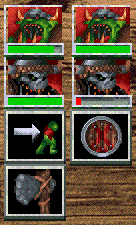 So far, so great, right? Well... Warcraft I is severely held back by its controls, AI, interface, balancing and all around clunkiness. Let's start with the controls. Click on a unit to select him, that part is simple. In order to move your unit, you have to either click on the move icon on the UI, or press the M key, and then click where you want to go. Every time you click and tell your unit to move somewhere, the move command is unselected, requiring you to either click on the icon or press the hot key every time you want your unit to move somewhere else, which when you're exploring unmapped territory that you need to carefully navigate, results in having to repeatedly reselect the move command every step of the way. Every action in the game that your units can perform is handled like this, requiring either clicking on an icon or pressing a hotkey before then clicking where you want to do that action on the map. In short, every action in the game requires two separate inputs to perform, even if that action is “move forward two steps”.
So far, so great, right? Well... Warcraft I is severely held back by its controls, AI, interface, balancing and all around clunkiness. Let's start with the controls. Click on a unit to select him, that part is simple. In order to move your unit, you have to either click on the move icon on the UI, or press the M key, and then click where you want to go. Every time you click and tell your unit to move somewhere, the move command is unselected, requiring you to either click on the icon or press the hot key every time you want your unit to move somewhere else, which when you're exploring unmapped territory that you need to carefully navigate, results in having to repeatedly reselect the move command every step of the way. Every action in the game that your units can perform is handled like this, requiring either clicking on an icon or pressing a hotkey before then clicking where you want to do that action on the map. In short, every action in the game requires two separate inputs to perform, even if that action is “move forward two steps”.
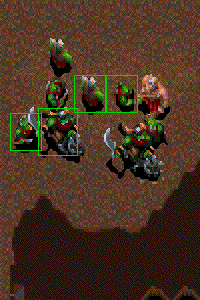 In modern strategy games I've played, exactly how controls are handled vary from game to game, but one of the common control schemes I've come to expect is that you would use the left mouse button to select units, while the right mouse button is used to perform basic actions such as moving units, helping cut back on unnecessary extra confirmations and inputs. However, standard Apple computer mice only have a single button, and even disregarding that, Warcraft I was released in 1994 when the genre was still young and the conventions weren't quite set in stone. I was able to mitigate the control issues a bit by plugging my modern multi-button mouse into my PowerMac and mapping the hotkeys to the extra buttons via USB Overdrive, an application that allows for further support and customisation with a wide selection of modern mice. Right click mapped to a M-keystroke, which is the movement hotkey, while the side buttons are mapped to the hotkeys for harvesting and attacking. It's a bit better, but still clumsy.
In modern strategy games I've played, exactly how controls are handled vary from game to game, but one of the common control schemes I've come to expect is that you would use the left mouse button to select units, while the right mouse button is used to perform basic actions such as moving units, helping cut back on unnecessary extra confirmations and inputs. However, standard Apple computer mice only have a single button, and even disregarding that, Warcraft I was released in 1994 when the genre was still young and the conventions weren't quite set in stone. I was able to mitigate the control issues a bit by plugging my modern multi-button mouse into my PowerMac and mapping the hotkeys to the extra buttons via USB Overdrive, an application that allows for further support and customisation with a wide selection of modern mice. Right click mapped to a M-keystroke, which is the movement hotkey, while the side buttons are mapped to the hotkeys for harvesting and attacking. It's a bit better, but still clumsy.
It's not just the amount of keystrokes that are the issue with the controls. Okay, so in order to pan the camera around with the mouse, you need to either hold down a hotkey that moves the camera in the direction you move the mouse in, or click on the part of the minimap in the top left that you want the camera to go to. This is totally fine, no issues there, except for the fact that the controls completely change when you have a unit’s action selected. Now the camera moves when you move the mouse cursor to the edge of the screen regardless of hotkey, while clicking on the minimap will instead tell your selected unit to go to whatever spot on the minimap you just clicked. Having basic controls suddenly change so needlessly results in a lot of flubbed inputs, but like the hotkey inputs, even if they are cumbersome they can be adapted to.
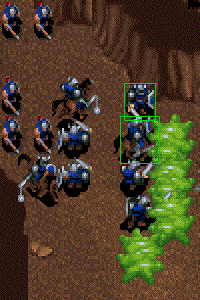 Okay, so have a look at this screenshot above. See all of these orcs and catapults? These are all my units here, the starting army of one of the later dungeon crawl-styled missions. You're generally going to need to manage a lot of units at once in Warcraft. So far, so obvious, what am I building up to here? Okay, so by clicking and dragging you can select multiple units at once. By multiple, I mean four. You can only select up to four units at once. In case the issues weren't already apparent, let me go over them. First off, you're already dealing with the cumbersome controls requiring a ton of extra inputs to do basic actions, but now those inputs are multiplied tenfold by having to move your units in such small groups one-by-one. In addition, formation is important in Warcraft. Generally you want your melee attackers in front, ranged attackers in the middle and magic users in the back. This is much harder to manage than it should be since every single time you want to move your units somewhere else, you naturally have to break up and reform your entire army every single time. Furthermore, if you accidentally click and drag a selection box over more than four units, which four units will actually be selected is seemingly random. You will need massive armies. The CPU opponent will always have huge amounts of soldiers ready to pile up on you the second you approach their base that are impossible to get by without plenty of backup. Naturally, the CPU on the other hand has no issue with commanding mass amounts of units at once, while also managing to somehow also have their clerics cast healing magic at the same time. This is the other reason I tend to not like the dungeon crawl levels. I love the idea of emphasising the importance of tactics and unit formations by giving the player limited units, but because of all of these control issues, actually maintaining effective defensive formations is tedious and slow.
Okay, so have a look at this screenshot above. See all of these orcs and catapults? These are all my units here, the starting army of one of the later dungeon crawl-styled missions. You're generally going to need to manage a lot of units at once in Warcraft. So far, so obvious, what am I building up to here? Okay, so by clicking and dragging you can select multiple units at once. By multiple, I mean four. You can only select up to four units at once. In case the issues weren't already apparent, let me go over them. First off, you're already dealing with the cumbersome controls requiring a ton of extra inputs to do basic actions, but now those inputs are multiplied tenfold by having to move your units in such small groups one-by-one. In addition, formation is important in Warcraft. Generally you want your melee attackers in front, ranged attackers in the middle and magic users in the back. This is much harder to manage than it should be since every single time you want to move your units somewhere else, you naturally have to break up and reform your entire army every single time. Furthermore, if you accidentally click and drag a selection box over more than four units, which four units will actually be selected is seemingly random. You will need massive armies. The CPU opponent will always have huge amounts of soldiers ready to pile up on you the second you approach their base that are impossible to get by without plenty of backup. Naturally, the CPU on the other hand has no issue with commanding mass amounts of units at once, while also managing to somehow also have their clerics cast healing magic at the same time. This is the other reason I tend to not like the dungeon crawl levels. I love the idea of emphasising the importance of tactics and unit formations by giving the player limited units, but because of all of these control issues, actually maintaining effective defensive formations is tedious and slow.
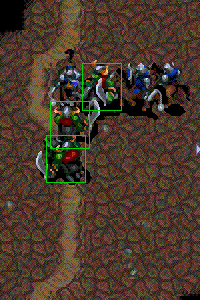 And then there's the AI. It's really bad. Likely impressive for the time, but an absolute nightmare to manage in practice. To be clear, I'm not talking about the AI of your CPU opponent, I'm primarily talking about the AI of your own units. Their pathfinding is atrocious, for a multitude of reasons. First off, they get stuck on trees and walls constantly, resulting in a unit you told to specifically go to a specific location just idling in some shrubs instead of going anywhere. Secondly, they prioritise hugging walls over getting to where you tell them to as soon as possible. I think I get the idea here, it's meant to ensure your units always have some cover, but in practice it results in units getting lost in mazes of trees and taking massive detours that have the unit in question go around in circles before actually going in the direction you told them to, in addition to giving the unit more chances to get stuck on terrain. Thirdly, sometimes units unprovoked will just start going one way, and then pause for a second while nothing is blocking them and then do a 180 turn and start going the other way. Fourthly, a unit that walks into another unit will also pause for a second before starting to move in another direction, wasting time. Fifthly, groups of units in open fields often gravitate towards moving in single-file when you tell them to move somewhere, which results in wasted time when enemies attack since the units behind the one in front bump into the leader, pause for a second and then have to reposition themselves somewhere where they can actually attack the opponent. Sixthly, sometimes when you tell a unit to attack an enemy right next to it, for no reason they'll refuse to actually start attacking them until they reposition themselves to the other side of the enemy in question, soaking up damage the entire time. Seventhly, if you tell a unit to go to a chokepoint such as a bridge, there's no guarantee that the unit in question won't instead try to approach the bridge from the other side, taking a detour straight into enemy territory in an attempt to get to the other side of the bridge that alerts all of the opposition into attacking you early when you're not ready. I could keep going, your units are constantly a hassle to manage as a result of this, and all the while you're also dealing with the control quirks on top of the idiotic AI.
And then there's the AI. It's really bad. Likely impressive for the time, but an absolute nightmare to manage in practice. To be clear, I'm not talking about the AI of your CPU opponent, I'm primarily talking about the AI of your own units. Their pathfinding is atrocious, for a multitude of reasons. First off, they get stuck on trees and walls constantly, resulting in a unit you told to specifically go to a specific location just idling in some shrubs instead of going anywhere. Secondly, they prioritise hugging walls over getting to where you tell them to as soon as possible. I think I get the idea here, it's meant to ensure your units always have some cover, but in practice it results in units getting lost in mazes of trees and taking massive detours that have the unit in question go around in circles before actually going in the direction you told them to, in addition to giving the unit more chances to get stuck on terrain. Thirdly, sometimes units unprovoked will just start going one way, and then pause for a second while nothing is blocking them and then do a 180 turn and start going the other way. Fourthly, a unit that walks into another unit will also pause for a second before starting to move in another direction, wasting time. Fifthly, groups of units in open fields often gravitate towards moving in single-file when you tell them to move somewhere, which results in wasted time when enemies attack since the units behind the one in front bump into the leader, pause for a second and then have to reposition themselves somewhere where they can actually attack the opponent. Sixthly, sometimes when you tell a unit to attack an enemy right next to it, for no reason they'll refuse to actually start attacking them until they reposition themselves to the other side of the enemy in question, soaking up damage the entire time. Seventhly, if you tell a unit to go to a chokepoint such as a bridge, there's no guarantee that the unit in question won't instead try to approach the bridge from the other side, taking a detour straight into enemy territory in an attempt to get to the other side of the bridge that alerts all of the opposition into attacking you early when you're not ready. I could keep going, your units are constantly a hassle to manage as a result of this, and all the while you're also dealing with the control quirks on top of the idiotic AI.
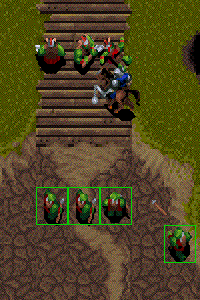 It's not just pathfinding either. Your units also suck at self preservation and fighting. It's an extremely common sight to see an enemy unit directly in front of one of your melee units while said melee unit does absolutely nothing and refuses to attack them until the enemy attacks them first. This means you can have a massive wall of military units ready to turn any opponent into mincemeat, but only one of them fights any invader at a time since the rest of the group isn't alerted to the fight happening right in front of them from two tiles away. Confusingly, they actually seem to have more active AI when they're off-screen, with units more readily attacking invaders in their line of sight when you're not looking at them. I'm guessing the idea is that when you look at them they're awaiting orders, but you're likely to always be looking at them during an attack since they're so unreliable no matter where you're looking.
It's not just pathfinding either. Your units also suck at self preservation and fighting. It's an extremely common sight to see an enemy unit directly in front of one of your melee units while said melee unit does absolutely nothing and refuses to attack them until the enemy attacks them first. This means you can have a massive wall of military units ready to turn any opponent into mincemeat, but only one of them fights any invader at a time since the rest of the group isn't alerted to the fight happening right in front of them from two tiles away. Confusingly, they actually seem to have more active AI when they're off-screen, with units more readily attacking invaders in their line of sight when you're not looking at them. I'm guessing the idea is that when you look at them they're awaiting orders, but you're likely to always be looking at them during an attack since they're so unreliable no matter where you're looking.
There's also the catapult AI. So, as mentioned, catapults can deal splash damage, and that splash damage can kill your own units, which naturally is bad. The catapult AI is programmed in a way where if left to its own devices without your direct commands, it will not automatically attack targets if the splash damage would hurt any of its allies. As is the case with the rest of the AI, this happens in theory, because I have still had instances of the catapult changing its target on its own to a new target that it can't attack without killing my units. It happened in the screenshots below. I told my swordsmen to attack one building, while telling the catapult to attack a separate building far away from the swordsmen to keep them safe. But then, the second the catapult destroyed the distant building, the auto-targeting caused it to automatically start attacking the same building as my swordsmen without my input. Lo and behold, the splash damage killed my swordsmen. Wank.
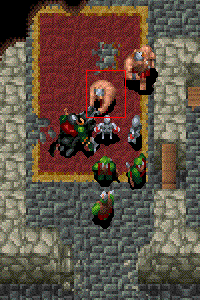 In spite of the controls, in spite of the AI, in spite of the UI, in spite of the pathfinding, in spite of the fact that that humans have the ability to make any unit invisible resulting in attacks out of nowhere when playing as the orcs, I actually did manage to adapt to Warcraft eventually. The game peaks in difficulty around the mid-game point, around when the game starts expecting you to take on multiple enemy bases at once with only a single base to your own name. Once you get over that hump, nothing Warcraft can throw at you afterwards will challenge you, especially since later levels start you with more developed bases and stronger units. By that point, you will have also figured out the ways to work around every quirk that the game can screw you over with. Once you hit that point, Warcraft I is not miserable to play, but it still feels like you're fighting the engine a bit with all of the finicky inputs required to ensure your units don't do something stupid that costs you the level. Either way, the core of the game is solid enough that if you have an easier time adapting to the controls than I, there's a genuinely solid game underneath the interface which is well balanced, thoughtfully designed and fun for you to enjoy.
In spite of the controls, in spite of the AI, in spite of the UI, in spite of the pathfinding, in spite of the fact that that humans have the ability to make any unit invisible resulting in attacks out of nowhere when playing as the orcs, I actually did manage to adapt to Warcraft eventually. The game peaks in difficulty around the mid-game point, around when the game starts expecting you to take on multiple enemy bases at once with only a single base to your own name. Once you get over that hump, nothing Warcraft can throw at you afterwards will challenge you, especially since later levels start you with more developed bases and stronger units. By that point, you will have also figured out the ways to work around every quirk that the game can screw you over with. Once you hit that point, Warcraft I is not miserable to play, but it still feels like you're fighting the engine a bit with all of the finicky inputs required to ensure your units don't do something stupid that costs you the level. Either way, the core of the game is solid enough that if you have an easier time adapting to the controls than I, there's a genuinely solid game underneath the interface which is well balanced, thoughtfully designed and fun for you to enjoy.
The Mac port isn't particularly great either, unfortunately. It runs at a higher resolution than the DOS version of Warcraft I, which sounds great on paper, but instead of using that extra screen space to either increase the field of view or redraw the sprites at a higher resolution, the dev team instead just slapped a xBRZ esque upscaling algorithm over all of the sprites and textures, similar to what some emulators use for upscaling filters on modern PCs. It looks bad. All the sprites look overly shiny and blobby, the floor textures don't tile properly, edges of rocks in the mines look squiggly instead of jagged like they're supposed to because they're jagged rocks and that's the point. Some things in real life are jagged and a filter can't detect that, so you end up with this. I also couldn't get the CD audio to play in-game, despite the fact that I'm playing the game on a physical CD, despite the fact that the Audio CD partition is mounted on my desktop when I put the CD in my Mac, and despite the fact that if I put the Warcraft disc in my Mac and play something else that uses CD audio like Quake, the Warcraft soundtrack plays through Quake just fine. It might be a compatibility issue, but I never figured out an easy fix. The port plays fine at least, but it doesn't look great and doesn't do anything else to make up for it looking worse than the DOS original.
Well, that's Warcraft. I'm excited to try Warcraft II, as it sounds like it remedies a lot of the issues I had with Warcraft I (especially in the Battle Net version) and I'm confident I'll enjoy it a lot. As for Warcraft I though, needless to say it didn't really do it for me. The game’s not awful by any means and has great ideas, but it's held back by a multitude of issues that could have been manageable on their own, but end up killing the game when all combined at once. This didn't turn me off playing the rest of Blizzard’s Mac library. It's clear that they are extremely close to making something fantastic here, and I'm excited to see that when they achieve it as I work through their backlog. Even if I don't enjoy playing it much, Warcraft I still has a welcome place in my physical Mac collection as an important piece of history and for representing the humble beginnings of Blizzard.
- Page written by MSX_POCKY, 25th July 2025
